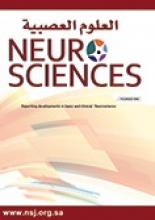Abstract
OBJECTIVE: To find the incidence, early outcome and the associated risk factors of hypoxic ischemic encephalopathy(HIE) in Madina Al-Munawara, Kingdom of Saudi Arabia (KSA) and compare it with other centers. Also, to find out whether any of these risk factors are preventable.
METHODS: We conducted a case controlled study of HIE in Madina Maternity and Children’s Hospital, Madina Al-Munawara, KSA over a one-year-period, from June 1995 to May 1996. All the inborn term babies without major congenital malformations that developed HIE were included in the study. A term baby born next to the index case was taken as a control for each case. Data was collected for possible risk factors. The incidence of risk factors in the 2 groups was analyzed and compared statistically.
RESULTS: A total of 70 cases of HIE were recorded in the study period giving an incidence of 5.5 cases per 1000 term births. This incidence is lower compared to many developing countries and comparable to other centers. Among the maternal factors, being a primigravida, with no antenatal care, presence of pregnancy induced hypertension, and complications of pregnancy were significantly higher in the study population. Similarly, the frequency of prolonged 2nd stage of labor, antepartum hemorrhage, delivery by emergency cesarean section (CS) or the use of instruments was significantly higher in the study group. Babies suffering from intrauterine growth retardation and male sex were also at significantly higher risk. The average hospital stay of the cases was 12 days. Twelve cases of severe HIE died before discharge from the hospital giving an overall mortality rate of 17.1%.
CONCLUSION: The incidence of HIE and birth asphyxia reported in different studies varies widely. The incidence in our hospital is much lower than reported in many studies from developing countries. The important associated risk factors includes being a primigravida mother, lack of antenatal care, pregnancy induced hypertension, prolonged 2nd stage of labor, delivery by use of instruments or emergency CS and intrauterine growth retardation. Improvement in antenatal care and intra-partum monitoring can decrease the incidence of HIE. The threshold for intervention in cases with fetal distress needs to be lower.
- Copyright: © Neurosciences
Neurosciences is an Open Access journal and articles published are distributed under the terms of the Creative Commons Attribution-NonCommercial License (CC BY-NC). Readers may copy, distribute, and display the work for non-commercial purposes with the proper citation of the original work.






